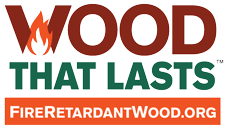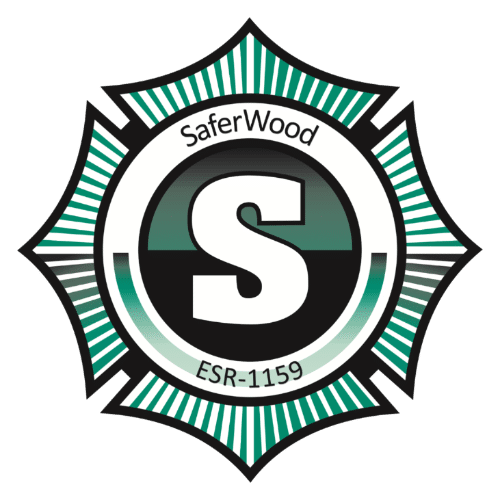Code compliance and specification documents
Other Documents
Additional resources

QAI, founded in 1995, is an independent third-party testing, inspection and certification organization, who produces our CERus-1031 and CERus-1042 reports. QAI holds accreditations for specific services by numerous, respected international accreditation bodies including the International Accreditation Services (IAS) and the Standards Council of Canada (SCC).

BC Wood is a nonprofit founded in 1989 that represents the voice of BC’s value-added wood products sector, of which SaferWood (Watkins Sawmills) is a long time member.

AWPA‘s technical library contains references for treated wood product manufacturers, treated wood specifiers, builders, code officials, and more.
FAQ
International Building Code, Section 2303.2, defines fire-retardant-treated wood (FRTW) as: “Wood products impregnated with chemicals by a pressure process.”
IBC § 2303.2.1 defines pressure process as: “For wood products impregnated with chemicals by a pressure process, the process shall be performed in closed vessels under pressures not less than 50 pounds per square inch gauge (psig) (345 kPa).”
It depends. FRTW may be required by code or selected by choice.
The authority-having jurisdiction (AHJ) determines through adoption of model codes (e.g, IBC, IWUIC, etc.) whether or not ignition resistant FRTW is required. This varies by city, county, and state, and is influenced by other factors like fire hazard severity zones (FHSZ-California), wildfire resiliency codes (WRC-Colorado), wildland urban interface designation (WUI), as well as other code amendments, design considerations, and client preferences.
In short, the best practice is to contact your AHJ (i.e., building and fire officials).
No. The use of paints, coating, stains or other surface treatments do not meet the requirements to be classified as FRTW or to be used in an exterior setting, as outlined in the International Building Code (IBC), Sections 2303.2, 2303.2.3, and 2303.2.7.
The reasons are because surface-applied fire retardants are prone to damage (during transport, storage, & installation) as well as performance degradation (from UV & weathering), and do not provide the one-time permanent protection to all surfaces as required by the International Building Code.
Yes. However, please consult SaferWood-Chemco for recommendations. Our proprietary fire retardant, Thermex-FR, is formulated to be ignition-resistant and is the only pressure impregnated fire-retardant to successfully pass a 10-year outdoor weathering test. The very nature of our ability to prevent the spread of flame and smoke, and extend weathering, also means choosing the correct stain, paint, or coating for proper compatibility.
Unless the local AHJ (Authority Having Jurisdiction) has prohibited its use the answer is, yes. SaferWood treated wood building products are ignition resistant and comply with IWUIC.
Per the International Wildland Urban Interface (WUI) Code Section 504.3 Protection of Eaves: Eaves and soffits shall be protected on the exposed underside by ignition-resistant materials or by material approved for not less than 1-hour fire-resistance-rated construction, 2-inch (51 mm) nominal dimension lumber, or 1-inch (25 mm) nominal fire-retardant-treated lumber or 3/4-inch (19.1 mm) nominal fire-retardant-treated plywood, identified for exterior use and meeting the requirements of Section 2303.2 of the International Building Code. Fascias are required and shall be protected on the backside by ignition-resistant materials or by materials approved for not less than 1-hour fire-resistance-rated construction or 2-inch (51 mm) nominal dimension lumber.
In most cases, no. To be fully compliant with IBC and IWUIC, an ignition-resistant wood building material must pass an extended fire-test for a total duration of 30 minutes. Outside a WUI zone or where the IWUIC has not been adopted a thermally modified wood product that has passed a 10-minute fire-test is acceptable for use. It is important to confirm two things: 1) most recent code adopted, and 2) WUI designation.
Yes. If it can fit in our tube, then we can treat it. Max size of material: 4 ft wide x 50 ft long.
Yes and no. ASTM E84/UL 723 is a Class A rating but to achieve this a wood building product must only pass a 10-minute fire-test. IBC and IWUIC ignition-resistant FRTW must pass an extended 20-minute fire-test for a total duration of 30-minutes. Essentially, achieving better than Class A. It is critical to understand this distinction and verify any product claiming to be WUI compliant and Class A has passed the extended 30-minute fire-test for flame spread and smoke development, and this is only performed after ASTM D2898 Accelerated Weathering.
Fire-retardant-treated products for exterior applications must be subjected to actual or accelerated weathering prior to fire testing. Sometimes referred to as the “800-inch rain test,” the ASTM D2898 test has two methods to simulate weathering. Method A subjects the materials to 12 one-week condition cycles of 96 hours of water exposure and 72 hours of drying at 140 degrees F, the equivalent of 800 inches of rainfall over 12 weeks. Method B subjects materials to 1,000 hours of 24-hour exposures featuring four hours of wetting, four hours of drying and eight hours of resting, with drying time at 150 degrees F with continuous UV exposure.
- Ignition resistant per IWUIC Section 503.2, Item 3, FRTW
- Fire retardant pressure treatment per IBC 2303.2.1
- ASTM E2768-11 Fire-Test-Response Extended 30 Minutes per ASTM E84/UL 723
- ASTM D2898-10 Accelerated Weathering per ASTM E84/UL 723
- Kiln-dried after treatment (KDAT) per IBC 2303.2.8 for moisture content
- Certification by an independent third-party quality control agency with IAS accreditation, i.e., ICC, ICC-ES, UL.


